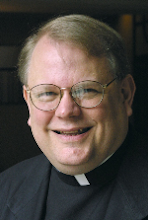
A Homily for Saint Lucy's Day
Each year, just twelve days before Christmas, we celebrate one of the most ancient feasts of the Church.
The commemoration of the martyrdom of Saint Lucy goes back to Fifth Century, and she is one of the first Saints to be remembered in the Sacred Liturgy.
Her story dates from the early Third Century, when the practice of the faith was still banned in most of the Roman empire. Few dared to profess a belief in Christ, lest they be tortured and killed by Emperors like the cruel Diocletian.
Few, save the martyrs that is, and one of the bravest of them all was Saint Lucy. Lucy, it seems, was forcibly married to a non-believer, who turned her in to the authorities for her belief in Christ. When they came to kill her for refusing to the worship the Roman gods a strange thing happened. While she was but a wisp of a girl, they could not move her. It was like she had been glued to the floor or that she weighed a few tons.
But that did not stop them. They tortured her on the spot with unspeakable torments, even blinding her. But still she did not renounce the Lord she loved. She professed her belief in him even unto death.
So Lucia, whose name means light, had her human sight taken from her, but even without her bodily eyes, she never stopped seeing the light that shines from the face of Jesus. It is the light which God created from the darkness and the chaos at the beginning of time, the light that led the chosen people from slavery into freedom, and the light which will illuminate the streets of the heavenly Jerusalem at the end of time. You remember that from the Book of Revelation: There will be no need for the sun or the moon or the stars, for the Lamb will be the light which will illumine the golden streets.
It was Lucy’s ability to see the light, even once she had lost her physical eyes, which inspired the tradition, observed even to this day by young Scandinavian women, of wearing a wreath of evergreens adorned with lit candles on their heads on Lucy’s day.
It’s not unlike the tradition of placing lights on an evergreen tree, real lights...real candles, as I used to observe when I was a seminarian forty years ago traveling through Germany on Christmas holiday. There was a little bed and breakfast by the train station in Munich where we used to stay...and every morning the daughter of the innkeeper would come down to the breakfast room and light the little white candles on the ends of each branch of the Christmas tree.
The evergreen, of course, was used in the medieval passion plays at which they would tell the story of Adam and Eve. That’s where the ornaments come from...from the red apples which would hang on the tree, ready to serve as the forbidden fruit for those taking the parts of Adam and Eve.
But even after the story of the Fall was over, the tree would remain on stage, as the birth of Jesus was acted out, for which the stage manager would add little lit candles to the branches already adorned with red apples....signs of the light of Christ come into our life under that star-studded sky in the fullness of time.
The evergreen is the only tree to keep its needles all through the winter snows. So then does it become a sign of the life which endures even through the passion and the winters of our lives, awaiting the resurrection on the last day. All because it is covered by the victorious light of him who defeated death by death on a tree...he who is our light, or in the words of the ancient Collect for midnight Mass at Christmas:
O God, who have made this most sacred night
radiant with the splendor of the true light,
grant, we pray,
that we who have known the mysteries of his light on earth
may also feast on his joys in heaven.
So, too, do the girls whose heads are surrounded by evergreens and lit candles in Churches throughout Sweden today anticipate the light of Christ which will soon dispel the longest hours of darkness that the Scandinavian people would have to endure during the entire year.
So, too, Saint Lucy reminds us who dwell in all kinds of darkness (the darkness of sin, the darkness of fear, the darkness of death) that the light of Christ will soon shed its warmth upon us once again. We need only see it with the eyes of faith, and we will know the beauty of his face.
Like the magi, the ones to whom the prophet Balaam today promised a star, may we seek his coming by looking for the star which will rise at his coming, not just in the skies to be seen by these eyes, but which will rise in our hearts and lead us to him who is our Savior and our Lord. Come Lord Jesus!
Monsignor James P. Moroney
Rector

